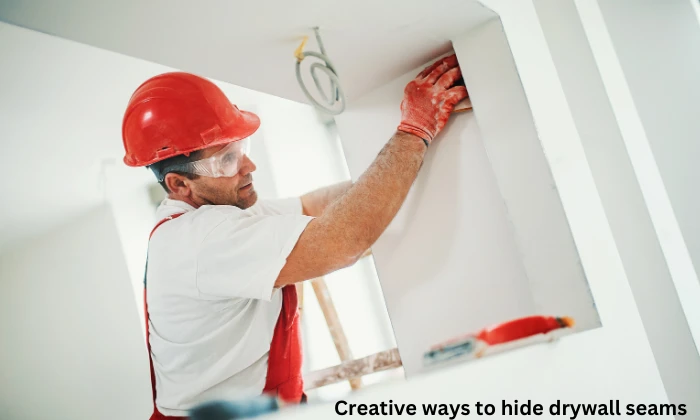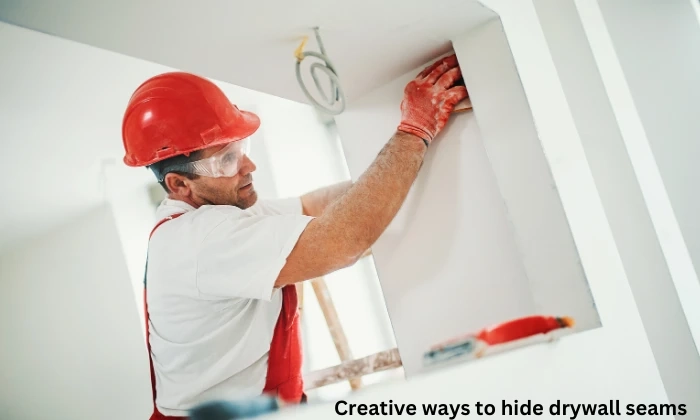Drywall seams can be a real eyesore, detracting from the smooth, polished look of your walls. While achieving a flawless finish can be challenging, there are 10 creative ways to hide drywall seams that can help you achieve a seamless appearance. In this guide, we\'ll explore ten effective techniques to conceal drywall seams, giving your walls a professional and aesthetically pleasing finish. Whether you\'re a DIY enthusiast or a professional contractor, these methods will equip you with the knowledge to tackle drywall seams with confidence.
1. Apply a Skim Coat of Setting Compound
One of the most effective ways to hide drywall seams is by applying a skim coat of setting compound. A skim coat is a thin layer of joint compound applied over the entire surface of the drywall to create a smooth, even finish. The setting compound, which dries faster and harder than regular joint compound, is ideal for this purpose because it helps to fill in any gaps or imperfections along the seams.
To apply a skim coat, start by mixing the setting compound to a smooth consistency. Using a wide drywall knife, spread the compound evenly over the seams and the surrounding area. Allow the compound to dry completely, then sand it lightly with fine-grit sandpaper to achieve a smooth surface. This method not only hides the seams but also provides a flawless canvas for painting or texturing.
2. Use Drywall Tape
Drywall tape is a tried-and-true method for hiding seams. There are two main types of drywall tape: paper tape and mesh tape. Both types can be effective, but they have different applications depending on the specific needs of your project.
Paper tape is often preferred for its strength and durability. To use paper tape, first apply a thin layer of joint compound over the seam. Then, press the tape into the compound, ensuring it is centered over the seam. Use a drywall knife to smooth out any bubbles or wrinkles, and apply another layer of joint compound over the tape. Once dry, sand the surface to blend the seam with the rest of the wall.
Mesh tape, on the other hand, is self-adhesive and easier to work with, especially for beginners. It is ideal for larger gaps and can provide a stronger bond. Simply press the mesh tape over the seam, apply joint compound over it, and smooth it out. The mesh tape allows the compound to seep through, creating a strong bond that hides the seam effectively.
3. Sand the Seam
Sanding is a crucial step in the process of hiding drywall seams. After applying joint compound, it\'s important to sand the seam to achieve a smooth, even surface that blends with the surrounding wall. Sanding helps to remove any ridges, bumps, or excess compound that may be visible after the compound dries.
To sand the seam, start with a medium-grit sandpaper to remove the bulk of the excess compound. Then, switch to a fine-grit sandpaper to achieve a smooth finish. Be sure to sand in a circular motion to avoid creating flat spots or uneven areas. After sanding, wipe the surface with a damp cloth to remove any dust before applying primer or paint.
For a truly seamless finish, consider using a sanding sponge or a pole sander, which allows you to reach higher areas without straining. Sanding is a simple but essential step in the process of creating a professional-looking wall that is free of visible seams.
4. Use Dark or Matte Paint
Choosing the right paint can make a significant difference in how well drywall seams are concealed. Dark or matte paint finishes are particularly effective at hiding imperfections, including seams. Unlike glossy or semi-gloss finishes, which reflect light and can highlight flaws, matte finishes absorb light, making seams and other imperfections less noticeable.
When using dark or matte paint, be sure to apply it evenly across the entire wall. Multiple thin coats are better than one thick coat, as this helps to prevent streaks and ensures a consistent finish. Additionally, consider using a quality primer before painting to ensure better adhesion and coverage.
For those looking to create a dramatic or modern look, dark paint can be a great choice. It not only hides seams but also adds depth and sophistication to the room. Whether you\'re painting an accent wall or an entire room, dark or matte paint can be a creative way to hide drywall seams while enhancing the overall aesthetic.
5. Hanging Up Wall Décor
Another creative way to hide drywall seams is by strategically placing wall décor over them. This method is both practical and stylish, allowing you to disguise imperfections while adding personality and character to your space.
Consider hanging artwork, mirrors, shelves, or even decorative tapestries over areas where seams are visible. These items can draw attention away from the seams and create a focal point in the room. Additionally, using larger pieces of décor can cover more significant imperfections, while smaller items can be grouped together to create a gallery wall effect.
This approach is particularly useful in living rooms, bedrooms, or other areas where wall décor plays a significant role in the overall design. By incorporating décor that reflects your personal style, you can effectively hide drywall seams while enhancing the visual appeal of your space.
6. Color Washing Technique
The color washing technique is a decorative painting method that can be used to hide drywall seams while adding texture and depth to your walls. This technique involves applying a glaze over a base coat of paint, then using a brush or sponge to create a washed, layered effect.
To achieve a color-washed look, start by applying a base coat of paint in your desired color. Once the base coat is dry, mix a glaze with a complementary or contrasting color. Apply the glaze to the wall using a brush or sponge, working in small sections to create a textured, washed effect.
The color washing technique is particularly effective at camouflaging seams because the varying shades and textures help to distract the eye from imperfections. This method works well in spaces where a rustic, vintage, or Mediterranean aesthetic is desired.
7. Use Paper Tape
As mentioned earlier, paper tape is a reliable and durable option for hiding drywall seams. However, it’s important to highlight that paper tape is especially effective for long-term results. Unlike mesh tape, which can sometimes crack over time, paper tape remains strong and intact, providing a lasting solution for hiding seams.
When using paper tape, be sure to apply it with care, smoothing out any air bubbles or wrinkles to ensure a flat, even surface. After applying the tape and joint compound, allow it to dry completely before sanding and finishing. This method is ideal for high-traffic areas where durability is a priority.
8. Use Better Drywall Mud
The quality of the drywall mud (joint compound) you use can significantly impact the appearance of your seams. Using a high-quality, lightweight drywall mud can make the application process easier and produce better results.
Lightweight drywall mud is easier to spread and sand, making it a great choice for both DIYers and professionals. It also dries faster and shrinks less than standard joint compound, reducing the need for multiple coats and extensive sanding.
When applying drywall mud, use a wide drywall knife to spread it evenly over the seams. Apply multiple thin layers, allowing each layer to dry before applying the next. This will help to build up a smooth surface that effectively hides the seams.
9. Use a Primer
Primer plays a crucial role in hiding drywall seams, especially if you plan to paint the wall. Applying a quality primer before painting ensures that the paint adheres well and covers any imperfections, including seams.
Primers are designed to seal the porous surface of the drywall and create a uniform base for the paint. They also help to hide any color differences between the drywall and the joint compound, resulting in a more even finish.
For best results, choose a primer that is specifically formulated for drywall. Apply it in a thin, even coat, and allow it to dry completely before painting. Using a primer not only improves the appearance of your walls but also extends the life of the paint job.
10. Wallpaper
Wallpaper is an excellent option for hiding drywall seams while adding texture and pattern to your walls. Modern wallpapers come in a wide range of styles, colors, and patterns, making it easy to find a design that suits your taste and complements your décor.
When applying wallpaper over drywall seams, it\'s important to prepare the surface properly. Sand the seams to create a smooth, even surface, and apply a primer or wallpaper adhesive to ensure the wallpaper adheres well.
Wallpaper with a textured or patterned design can be particularly effective at disguising seams, as the texture and pattern help to distract the eye from any imperfections. Additionally, wallpaper can be a cost-effective and creative way to transform a room without the need for extensive  s or renovations.
s or renovations.
Conclusion
Hiding drywall seams may seem like a daunting task, but with the right techniques and materials, you can achieve a flawless finish that enhances the beauty of your walls. From applying a skim coat of setting compound to using dark or matte paint, these creative ways to hide drywall seams offer a variety of options to suit different styles and preferences. Whether you’re a DIYer looking to improve your home or a professional contractor seeking to deliver top-notch results, these methods will help you achieve a seamless, polished look that stands the test of time.
By incorporating these techniques into your next drywall project, you can confidently tackle even the most challenging seams, creating walls that are smooth, even, and free of visible imperfections. With a little creativity and attention to detail, you can transform your space into a work of art that reflects your personal style and adds value to your home.


